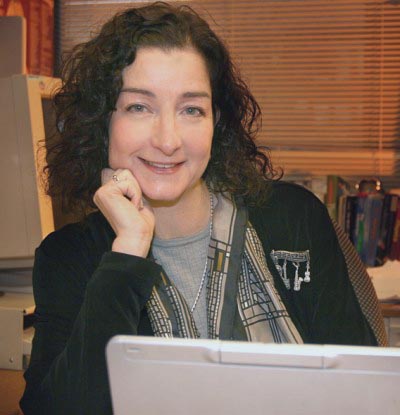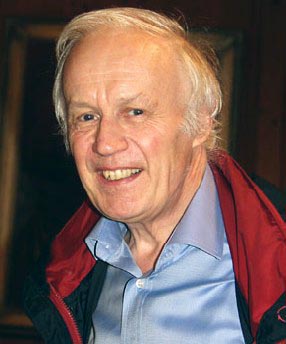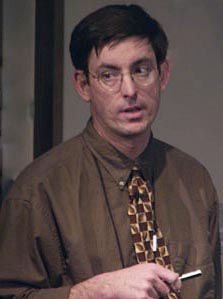Science does not always move forward in quantum leaps, iteration follows iteration but sometimes there are backward slips. An Illinois team has shown that current theories cannot account for results seen in the latest round of experiments on superconducting materials.
Laura Greene, post-doctoral researcher Wan Kyu Park, and undergraduate student Justin Elenewski, Anthony Leggett and graduate student Vladimir Lukic of the University of Illinois at Urbana-Champaign and John Sarrao and Joe Thompson of Los Alamos National Laboratory in New Mexico used the highly sensitive technique of point-contact spectroscopy to explore so-called Andreev reflection between a normal metal and a heavy-fermion superconductor and found a serious discrepancy between current theory and their data.

Laura Greene (Photo by Kwame Ross)
Andreev reflections are phenomena that occur at the interface between a metal and a superconductor and involve the transfer of electrons and their positive counterparts, so-called holes. According to conventional theory, there is a mismatch between the velocity at which electrons can move in metals, the Fermi velocity, and their velocity in heavy-fermion superconductors, such as CeCoIn5 (cerium-cobalt-penta-indium). This discrepancy is so large that Andreev reflections should not occur, explains Greene, but physicists can observe this phenomenon and reproducibly measure it as a matter of course using point-contact spectroscopy. Greene and Park have obtained measurements of Andreev reflection at the interface of a normal metal (gold) and the heavy-fermion superconductor CeCoIn5. The electrons in such materials are much more massive than the familiar free electrons chemists commonly discuss and are more correctly known as quasi-electrons.
Greene explains Andreev reflection by analogy with light reflections. When light is incident on glass, some of the light is reflected due to the difference between the refractive index of air and of glass, and some is transmitted into the glass. Light travels more slowly in the denser medium, glass, than in air and one can think of the refractive index as the velocity difference between the glass and air. The larger the velocity mismatch, the more light will be reflected. Diamonds have a higher refractive index than glass so reflect more light.

Anthony Leggett
Likewise, electrons travelling between a metal and a superconductor can be reflected at the interface between the different materials just as light is reflected from the surface of the glass. Again, the larger the mismatch in Fermi velocities, analogous to the refractive index, the more electrons will be reflected and the less transmitted.

John Sarrao
In Andreev reflection electrons penetrate a material but are reflected back as holes. This should not happen when electrons pass from a metal into a superconductor because the Fermi velocities are so different that most if not all the electrons should be reflected and none penetrate. Nevertheless Greene and her colleagues have observed this phenomenon.
Our measurements prove that existing theories cannot account for Andreev reflection between normal metals and heavy-fermion superconductors,” explains Greene, who presented the findings at the meeting of the American Physical Society in Los Angeles at the end of March. “The bottom line is, we can understand Andreev reflection occurring between a normal metal and a superconductor, but we cannot understand it occurring between a normal metal and a heavy-fermion superconductor, Greene adds. We need a whole new theoretical formulation to explain this phenomenon.
Work on high-Tc superconductors has aided us a great deal in our understanding of heavy-fermion superconductors, Greene told Spotlight, and I am certain that our recent studies on heavy-fermion superconductor will help shed light on the mechanism of superconductivity in the high-Tc superconductors.
Greene confesses that her research is curiosity driven but adds that if it helps us discover the real mechanism of unconventional superconductivity … maybe even high-Tc superconductivity, then it also holds promise of designing even higher-temperature superconductors.
Further reading
Andreev reflection at the normal-metal / heavy-fermion superconductor (HFS) interface: APS Meeting 2005
http://meetings.aps.org/Meeting/MAR05/Event/27588
Laura Greene
http://physics.illinois.edu/people/profile.asp?lhgreene
Anthony Leggett
http://physics.illinois.edu/people/profile.asp?aleggett
Suggested searches
superconductors